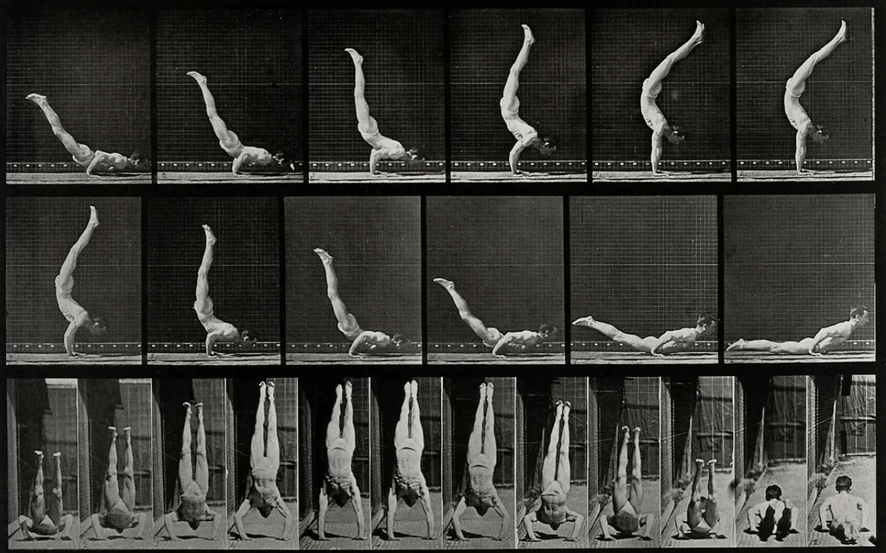On Progression & Movement // Eadweard Muybridge
- Ewelina Olechowska
- Aug 27, 2020
- 7 min read
In the spring of 1872 a man photographed a horse. With the motion studies that resulted it was as though he were returning bodies themselves to those who craved them — not bodies as they might daily be experienced, bodies as sensations of gravity, fatigue, strength, pleasure, but bodies become weightless images, bodies dissected and reconstructed by light and machine and fantasy […] Source
This month I’ve taken time to revisit Eadward Muybridge and his prolific stop-motion photography of the late 19th century. By revisiting, I’m re-immersing myself in both the beauty and admiration of not only his work, but his influence on the technological revolution within the context of his time, as well as on the concept of time in general (the latter point, seemingly most applicable to the current events at hand, where the concept of time continues to grow more and more elusive amidst quarantine days... yes, I’ve become starkly dependent on my iCal each morning to remind me what day of the week I’m starting). Also (and more so), to the latter point: how progress inherently evolves with the passage of time, and how much I’ve embodied progression in my artistic process to date (more on that later).
I initially discovered Muybridge during the thick of my Master’s of Architecture thesis in 2015, which explored temporal notions of home for travelers (pilgrims) along the camino in Santiago de Compostela - a renown, month-long pilgrimage excursion along the northern border of Spain. As part of my thesis research, I became enthralled with user group analysis of the pilgrim - considering everything from their intentionality behind embarking on the camino (most often spiritual, reflective, and/or personal) to their physical needs which my design intervention sought to address (eating, resting, connection & community), and also the phenomenology and objective qualities of walking. Simple while it may seem, and something we all surely take for granted, but to the pilgrim, who on average covers 20km (12-13 miles) of distance on their feet daily, the action of walking each day becomes an inherent part of their daily ritual - and something I could not go without considering within the context of my design development.
It was among the early Google trenches of my walking research that I came across Eadweard Muybridge and discovered his photographic studies in motion. I think what initially caught my attention about his work (aside from the beautiful nostalgic/old-timey feel of his photo compilations), was the innate, powerful, simplicity of the captured subjects and their actions — a man walking, a horse galloping, a couple waltzing — as well as a profound dynamic of well, dynamism, and stillness that each of his works portrayed — the encapsulation of various actions we know to be fluid, now brought to light in a completely new context: one of pause. Within each collotype, you are faced to consider and question the seemingly “basic” concepts of time - does this piece embody the past, present, or future, and/or does it embody them all, and/or/if/so at what point does a frame stand to represent the past, present, or future, OR even perhaps - is it even sensible to try applying notions of time within the context of Muybridge’s work, because in a way, it can be all of those things at once as much as it can also be none of those things at once (?!)
Rebecca Solnit, may have perhaps more eloquently captured this thinking of mine in her book, River of Shadows: Eadweard Muybridge and the Technological Wild West:
[Muybridge] had captured aspects of motion whose speed had made them as invisible as the moons of Jupiter before the telescope, and he had found a way to set them back in motion. It was as though he had grasped time itself, made it stand still, and then made it run again, over and over. Time was at his command as it had never been at anyone’s before. A new world had opened up for science, for art, for entertainment, for consciousness, and an old world had retreated farther.
Also, this:
His trajectory ripped through all the central stories of his time — the relationship to the natural world and the industrialization of the human world, the Indian wars, the new technologies and their impact on perception and consciousness. He is the man who split the second, as dramatic and far-reaching an action as the splitting of the atom.
Excerpts from The Annihilation of Space and Time: Rebecca Solnit on How Muybridge Froze the Flow of Existence, Shaped Visual Culture, and Changed Our Consciousness via Brain Pickings
Muybridge’s work was profound as precedent for helping me consider a lot of the above questions in my research, allowing me to recognize underlying themes of movement, dynamism, and rhythm for the pilgrim, ultimately drawing conclusions on this cyclic activity that would influence the final design of my thesis project. Below are a few analytical diagrams I developed to help translate some of these ideologies into more tangible applications (for those curious on my process):
01 / Marcel Duchamp / Nude Descending a Staircase No.2 (1912)

02 / Etienne-Jules-Marey / Man Walking (1890-1891)

03/ Eadweard Muybridge / A Man Walking (1887)
What’s more, is his work allowed me to gain more insight on concepts of time as they relate to the physical progression through place. I was able to recognize that for the pilgrim, the ideology of past, present, and future are all acknowledged daily amidst their walk and progress forward. The timing of when these periods occurred held less relevance as they related to a deeper understanding of how they were experienced (or presumed to be experienced) by the sojourner. In my thesis, I write:
The progressive and recurrent action of walking calls for a present state of being that is ever evolving, continually looking towards the future while also contesting with the past. Progressing forward, Paulo Coelho poetically remarks that the pilgrim “adapt[s] oneself to new situations and receiv[es] in return all of the thousands of blessings that life generously offers to those who seek them”. This acceptance embodies the subjective connectivity the pilgrim experiences with the world. In walking in the present successively towards the future, the past is collectively acknowledged through an awareness of not only the distance traveled, but also through the connectivity with the surroundings: “Moving through a landscape creates an embodied relation to the material world and this allows us to contemplate how the experience of places was part of the constitution of social meaning in prehistory, expressed by the construction of monuments”.

Within this excerpt, I recognize I may perhaps have answered a few of my earlier questions re: Muybridge and the tenses of time embodied in his work. The parallels I draw between the daily walk for the pilgrim and the progression of time seem to wholly encompass all of past, present, and future in beautiful tandem, but only after gaining an awareness of self and place, that is - acknowledging your personal being and intention in the moment, while consciously moving forward with whole open-mindedness and connection to your surroundings. What’s more, is that in recognizing this connection and continuing to move forward, we are making a conscious choice to progress and accept growth and expansion along the journey.
Maybe this is getting too deep, but I’ve been drawn to consider thinking like this more and more as I’ve been progressing down my own personal “path” of reconnecting with working with my hands through my recent paintings. I realize that for a long while I truly lacked (or perhaps, just ignored) a real intentionality behind my work — subscribing instead to creating for the sake of creating by the rules (instead of facing some discomfort in freely exploring without incessantly worrying about perfection or perception from peers) — and that I likewise lacked (or ignored) embracing the presence of the moment and trusting the process to guide and inform me of my next decisions. Suffice to say, I may have been showcasing progression on the surface via quantity of work, but surely not through depth and quality. Recognizing this now, I feel that I’ve come quite a way in gaining a newfound sense of awareness for why I am painting (because I actually, simply, just really freaking enjoy it), as well as approaching how I paint: (01) only when I’m truly compelled to (avoiding it solely because I “should” or for the sake of producing social media content) (02) when I’m in a good mood, and (03) always in a good setting (natural lighting, ambient/classical music on and *vibing*).

It may sound simple (maybe too simple?) but it’s truly taken me quite a ways to get here. Ultimately, I wouldn’t have had the process go any other way (good or bad) because I believe all of my past experiences and lessons have led me to where I am in this moment in time (and I am truly embracing and loving this moment in time!)
What’s more, is I am continuing to progress on this journey and embrace new opportunities, not only for making, but also for sharing. With that being said, I’m excited to announce a studio domka SHOP is finally in the works (!!!) This has truly been a longggg time coming, but I’m thrilled to finally be at a place where I feel ready (enough) to start sharing my work with the world in a more tangible way. Aside from the personal growth with both my self and my process (which I think inherently had to happen before I could ever truly feel “ready”), I’ve received so much beautiful encouragement and support from many humans in my life, helping me recognize I can (and should) take this next step in my creative journey. Still very much a work in progress, it is happening - and will be coming at some point in September (sharing this so I can be held accountable friends!) So with all that, I’ll conclude this post with an exciting *stay tuned* and continued high energy vibes with ongoing progress.
//e











Comments